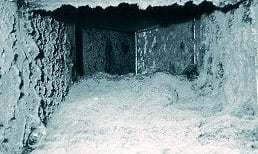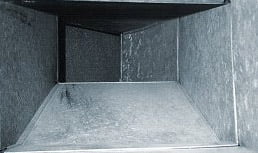Indoor Air Quality
San Gabriel Valley & Los Angeles, CA
Most of us spend much of our time indoors, where indoor air quality can directly impact our health. The air we breathe in our homes and offices may contain pollutants, including chemicals, gases, and living organisms like mold and pests, putting us at risk for health issues.
Some pollutants cause health problems such as sore eyes, burning in the nose and throat, headaches, or fatigue. Other pollutants cause or worsen allergies, respiratory illnesses (such as asthma), heart disease, cancer, and other serious long-term conditions. Sometimes individual pollutants at high concentrations, such as carbon monoxide, cause death.

BEFORE

AFTER
We provide duct cleaning, Lennox indoor air quality products like air cleaner & APCO-X whole-house air treatment system.
Understanding Indoor Air Quality
Radon is a radioactive gas that is formed in the soil. It can enter indoors through cracks and openings in floors and walls that are in contact with the ground.
Radon is the leading cause of lung cancer among nonsmokers, and the second leading cause of lung cancer overall.
Secondhand smoke comes from burning tobacco products. It can cause cancer and serious respiratory illnesses.
Children are especially vulnerable to secondhand smoke. It can cause or worsen asthma symptoms and is linked to increased risks of ear infections and Sudden Infant Death Syndrome (SIDS).
Combustion Pollutants are gases or particles that come from burning materials. In homes, the major source of combustion pollutants are improperly vented or unvented fuel-burning appliances such as space heaters, woodstoves, gas stoves, water heaters, dryers, and fireplaces. The types and amounts of pollutants produced depends on the type of appliance, how well the appliance is installed, maintained, and vented, and the kind of fuel it uses. Common combustion pollutants include:
Carbon monoxide (CO) which is a colorless, odorless gas that interferes with the delivery of oxygen throughout the body. Carbon monoxide causes headaches, dizziness, weakness, nausea, and even death.
Nitrogen dioxide (NO2) which is a colorless, odorless gas that causes eye, nose and throat irritation, shortness of breath, and an increased risk of respiratory infection.
Volatile organic compounds (VOCs) are chemicals found in paints and lacquers, paint strippers, cleaning supplies, varnishes and waxes, pesticides, building materials and furnishings, office equipment, moth repellents, air fresheners, and dry-cleaned clothing. VOCs evaporate into the air when these products are used or sometimes even when they are stored.
Volatile organic compounds irritate the eyes, nose and throat, and cause headaches, nausea, and damage to the liver, kidneys, and central nervous system. Some of them can cause cancer.
Asthma triggers are commonly found in homes, schools, and offices and include mold, dust mites, secondhand smoke, and pet dander. A home may have mold growing on a shower curtain, dust mites in pillows, blankets or stuffed animals, secondhand smoke in the air, and cat and dog hairs on the carpet or floors. Other common asthma triggers include some foods and pollutants in the air.
Asthma triggers cause symptoms including coughing, chest tightness, wheezing, and breathing problems. An asthma attack occurs when symptoms keep getting worse or are suddenly very severe. Asthma attacks can be life threatening. However, asthma is controllable with the right medicines and by reducing asthma triggers.
Molds are living things that produce spores. Molds produce spores that float in the air, land on damp surfaces, and grow.
Inhaling or touching molds can cause hay fever-type symptoms such as sneezing, runny nose, red eyes, and skin rashes. Molds can also trigger asthma attacks.
Take steps to help improve your air quality and reduce your IAQ-related health risks at little or no cost by:
Controlling the sources of pollution:
Usually the most effective way to improve indoor air is to eliminate individual sources or reduce their emissions.
Ventilating:
Increasing the amount of fresh air brought indoors helps reduce pollutants inside. When weather permits, open windows and doors, or run an air conditioner with the vent control open. Bathroom and kitchen fans that exhaust to the outdoors also increase ventilation and help remove pollutants. Always ventilate and follow manufacturers' instructions when you use products or appliances that may release pollutants into the indoor air.
Changing filters regularly:
Central heaters and air conditioners have filters to trap dust and other pollutants in the air. Make sure to change or clean the filters regularly, following the instructions on the package.
Adjusting humidity:
The humidity inside can affect the concentrations of some indoor air pollutants. For example, high humidity keeps the air moist and increases the likelihood of mold.
Keep indoor humidity between 30 and 50 percent. Use a moisture or humidity gauge, available at most hardware stores, to see if the humidity in your home is at a good level. To increase humidity, use a vaporizer or humidifier. To decrease humidity, open the windows if it is not humid outdoors. If it is warm, turn on the air conditioner or adjust the humidity setting on the humidifier.






